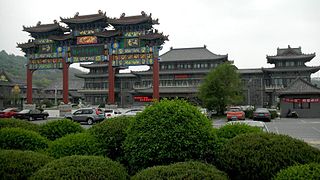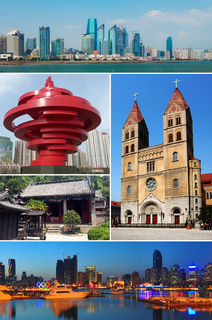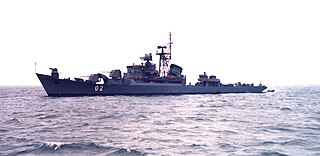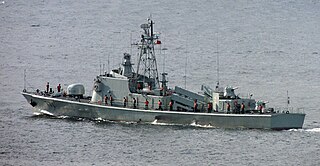 Anshan (101) at the Qingdao Naval Museum | |
| History | |
|---|---|
| Name: | Rekordny |
| Builder: | C-324 Factory, USSR |
| Laid down: | 1936 |
| Launched: | 1940 |
| Acquired: | October 1954 |
| Decommissioned: | April 1992 |
| Renamed: | Anshan |
| Fate: | Museum and training ship |
| General characteristics | |
| Class and type: | Anshan-class destroyer |
| Displacement: | 2,581 tons |
| Length: | 112.5 m (369 ft) |
| Draught: | 10.2 m (33 ft) |
| Speed: | 34 knots (63 km/h; 39 mph) |
Rekordny (Russian : Рекордный), launched in 1940, was originally operated by the Soviet Navy. It was subsequently bought by the People's Liberation Army Navy (PLAN) and renamed Anshan (Chinese :鞍山号; pinyin :Ānshān hào). The ship was transferred to the People's Liberation Army Navy from the USSR in October 1954 along with three other former Gnevny-class destroyers of the Soviet Navy as part of a larger transfer deal which also saw the transfer of submarines, minesweepers and torpedo boats. [1] Rekordny had served with the Soviet Union throughout the Second World War, during which she shot down two German airplanes. [2]

Russian is an East Slavic language, which is official in the Russian Federation, Belarus, Kazakhstan and Kyrgyzstan, as well as being widely used throughout Eastern Europe, the Baltic states, the Caucasus and Central Asia. It was the de facto language of the Soviet Union until its dissolution on 25 December 1991. Although, nowadays, nearly three decades after the breakup of the Soviet Union, Russian is used in official capacity or in public life in all the post-Soviet nation-states, as well as in Israel and Mongolia, the rise of state-specific varieties of this language tends to be strongly denied in Russia, in line with the Russian World ideology.

The Soviet Navy was the naval arm of the Soviet Armed Forces. Often referred to as the Red Fleet, the Soviet Navy was a large part of the Soviet Union's strategic plan in the event of a conflict with opposing super power, the United States, the North Atlantic Treaty Organization (NATO), or another conflict related to the Warsaw Pact of Eastern Europe. The influence of the Soviet Navy played a large role in the Cold War (1945-1991), as the majority of conflicts centered on naval forces.

The People's Liberation Army Navy, also known as the PLA Navy, is the naval warfare branch of the People's Liberation Army, which is the armed wing of the Communist Party of China and, by default, the national armed forces of the People's Republic of China. The PLAN can trace its lineage to naval units fighting during the Chinese Civil War and was established in September 1950. Throughout the 1950s and early 1960s, the Soviet Union provided assistance to the PLAN in the form of naval advisers and export of equipment and technology. Until the late 1980s, the PLAN was largely a riverine and littoral force. However, by the 1990s, following the fall of the Soviet Union and a shift towards a more forward-oriented foreign and security policy, the leaders of the Chinese military were freed from worrying over land border disputes, and instead turned their attention towards the seas. This led to the development of the People's Liberation Army Navy into a green-water navy by 2009. Before the 1990s the PLAN had traditionally played a subordinate role to the People's Liberation Army Ground Force.
The ship was commissioned into the Chinese navy as the destroyer Anshan, named after the industrial city of Anshan in the province of Liaoning. She was assigned the pennant number 101. During the 38 years she served the PLAN, she was visited by nine foreign dignitaries as well as two Chinese leaders: Zhou Enlai and Deng Xiaoping
Ship commissioning is the act or ceremony of placing a ship in active service, and may be regarded as a particular application of the general concepts and practices of project commissioning. The term is most commonly applied to the placing of a warship in active duty with its country's military forces. The ceremonies involved are often rooted in centuries old naval tradition.

Anshan is the third-largest prefecture-level city in Liaoning Province, China. Situated in the central area of the province, Anshan is about 92 kilometres (57 mi) south of Shenyang, the provincial capital. Anshan is on the boundary between the mountains of eastern Liaoning and the plains of the west. The prefecture has a population of 3,584,000 people and covers an area of about 9,252 km2 (3,572 sq mi). The distance from the east to the west of the prefecture is 133 km (83 mi). The area contains the famous Qianshan National Park. The city's name is derived from the shape of a nearby mountain that resembles the shape of a horse's saddle, which can be seen on the left (west) about five minutes before the northbound train arrives at Anshan Station. Anshan is home to the Anshan Iron and Steel Group, one of the largest steel producers in China. Anshan is sister cities with Sheffield, the UK.

Liaoning is a province located in the northeastern part of China, being the smallest but the most populous province in the region. The modern Liaoning province was established in 1907 as Fengtian or Fengtien province and was renamed Liaoning in 1929, also known as Mukden Province at the time for the Manchu pronunciation of Shengjing, the former name of the provincial capital Shenyang. Under the Japanese-puppet Manchukuo regime, the province reverted to its 1907 name, but the name Liaoning was restored in 1945 and again in 1954.
She was decommissioned in April 1992 and anchored at the Naval Museum at Qingdao.

Qingdao is a major city in the east of Shandong Province on China's Yellow Sea coast. It is also a major nodal city of One Belt, One Road (OBOR) Initiative that connects the Asia and Europe. It has the highest GDP of any city in the province. Administered at the sub-provincial level, Qingdao has jurisdiction over six districts and four county-level cities. As of 2014, Qingdao had a population of 9,046,200 with an urban population of 6,188,100. Lying across the Shandong Peninsula and looking out to the Yellow Sea, it borders Yantai to the northeast, Weifang to the west and Rizhao to the southwest.












